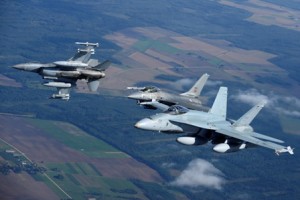On September 1, four CF-188s began patrolling the skies over the three Baltic states of Latvia, Lithuania and Estonia as part of a 10-year NATO mission known as Baltic Air Policing (BAP).
The deployment is the first time Canada has participated in the BAP mission – the Royal Canadian Air Force deployed five fighter jets as part of a NATO-led Iceland Air Policing operation in 2011 – and the first time F-18s from any country have been involved in the mission.
The Canadian Armed Forces, however, were contributors to the original air policing concept.
In fact, as Mark Aruja, a former CAF member now with Thales Canada, recalled in a recent article for the Conference of Defence Associations, the BAP deployment marks 20 years since he was seconded to Tallinn, Estonia, to help develop the “conceptual rationale” for an Estonian air force and advise its chief of the air force on integration with NATO – tasks that eventually saw the creation of the Baltic Air Surveillance initiative in the late 1990s.
With no fighter jets and only limited assets to conduct air sovereignty – the Lithuanian air force, for example, relies on C-27 Spartans, Czech-built L-410 Turbolet short-range transport aircraft and helicopters for air power, as well as one L-39 Albatros for jet training – the three Baltic air forces have turned to allies to police their skies.
“What they have done in coming together is ensure that each one of their air bases is really focused on creating a turnkey operation for NATO countries to roll in, conduct a four month mission and then roll out,” says LCol David Pletz, commander of an Air Task Force (ATF) deployed as part of Op Reassurance that has recently transitioned from a four-month training mission in Romania to BAP.
“I can’t say if they are pointing in the direction of having their own fighters. Their focus from what I have seen is primarily on infrastructure and support capabilities. It’s clear [they] have put an exceptional amount of effort into the infrastructure at the bases. For us to show up here was extremely easy.”
As reported in the Aug/Sep issue of Vanguard, the Air Task Force is also a validation of the RCAF’s larger Air Expeditionary Wing concept, which can be scaled to meet the requirements of an operation. Pletz said he was able to draw back the resources when transitioning from Romania because of the quality of the Lithuanian infrastructure.
“We were able to downsize (from about 200) personnel to about 135. We didn’t require firefighters and we were able to cut down considerably on the engineering component – in Romania we had to do quite a bit of building.
“We had an air bridge set up between the two countries, got here and started running in quick order. We landed with the four jets on 26 August and were flying missions on the 27th with British Typhoons, Polish MiG-29s, French Mirages and now with German Eurofighters and Portuguese and Dutch F-16s. In terms of interoperability, it has been extremely easy for us to integrate into – not just radios, but the command and control structure, Link 16, etc.
“I’m seeing the ATF construct in action and I’m a big fan. A few months ago we had no idea we would be coming to Lithuania, so to be able to turn on a dime and do that has been really cool to watch. It speaks to the flexibility of our people and the flexibility of air power.”
Much of the BAP involves monitoring Russian air traffic into and out of the small enclave of Kaliningrad on the Baltic Sea between Lithuania and Poland. Though some of the communications and code words differ, Pletz says it’s familiar ground for Canadian pilots used to flying NORAD missions. “The entire mission is based on air sovereignty for the three Baltic states. What that means is that any type of non-NATO aircraft that is not on a flight plan, not squawking or not talking, we will get scrambled on them to conduct a visual identification and then either shadow or escort them out of the airspace. It’s very similar to the NORAD mission.”
While NORAD aircraft monitor Russian Bears over the Arctic, however, Pletz says he is now tracking fighters, transport and intelligence (ELINT) gathering aircraft.
For Pletz, one of the greatest values of the ATF is a command team approach that emphases ideas. “That has been a key to success for us. It’s been awesome bringing up different ways of doing business. People have taken ownership and we’re not adverse to changing. We use the expression ‘max flex’ a lot. Well, I’ve got a new definition of that since day one in Romania.”
For more on the Air Expeditionary Wing and the Air Task Force, see: https://vanguardcanada.com//wings-over-romania-nato-operation-bolsters-expeditionary-concept/

